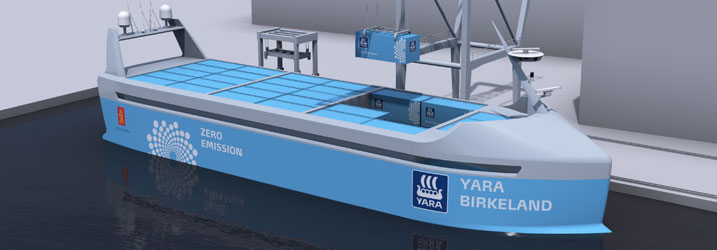Scared at the idea of Driverless Cars? How about Crewless Container Ships?
The concept puts a whole new perspective into the phrase “All hands on deck!”
No it’s not a myth, a dream, or a science fiction idea. By 2018 the first crewless, automated cargo ship is expected to launch with a crew and will be fully autonomous by 2020!

The Norwegian-built boat, Yara Birkeland, dubbed the “Tesla of the Seas”, will be a relatively small “feeder” cargo ship, initially transporting containers of fertilizer from the Yara factory, 37 miles down a fjord on Norway’s Baltic Sea Coast, to a larger port, where the containers will be transferred onto bigger seagoing ships. It is being built in partnership between shipping company Yara and the maritime engineering group, Kongsberg Gruppen ASA. It will have the capacity for 100 to 150 shipping containers, which currently are transported by diesel truck. Moving transport from road to sea will eliminate 40,000 diesel truck journeys per year, hopefully reducing noise and dust emissions, improving the safety of local roads and reducing nitrous oxide and CO2 emissions.
The electrically powered Yara will use GPS, radar, cameras and sensors to navigate itself around other shipping and it will be able to dock on its own. To begin with it will be crewed from an on-board control centre, but this will eventually be moved ashore and the ship will be remotely operated.
It is expected to cost around $25 million – about three times as much as a standard container ship of the same size. The investors hope, however, that without the need for fuel and crew, the annual running costs would be cut by 90%.
If Yara is successful, it is planned that bigger ships, on longer routes, will be developed, once international regulations for crewless vessels are in place.
Military drone ships have been operating for some time and Norway has been involved in pushing forward the science of drone ships. A prototype autonomous offshore utility ship has been developed and an uncrewed oil rig support ship will be the next project to be built. But long-range, crewless, merchant ships are a huge step further on and it could be a long time before merchant seamen are out of a job.
Rolls-Royce Holdings Plc too have been working on the concept of eliminating crew. They rolled out a virtual reality prototype of an autonomous ship as early as 2014. According to the company, the ship will be 5% lighter, and burn 15% less fuel than a comparable human crewed vessel.
Another company, BHP Billiton Ltd., the world’s largest mining company and one of the world’s largest dry bulk charterers are studying the introduction of giant automated cargo ships, which are intended to carry everything from ore to coal. They intend to power their ships by BHP gas and hope to be employing the technology within a decade.
Like most innovations there are pros and cons. On the positive side there is the issue of human safety. Crew members would no longer be exposed to rough seas, hazardous weather and pirate danger. The concept could be a lifeline for the global shipping industry, which has been struggling for years with overcapacity and falling rates, leading to dwindling profits and even bankruptcy for some major firms. The commercial rationale for autonomous ships is clear enough. Figures produced by U.S. Coastguard estimate that human error accounts for up to 96% of all maritime casualties. It is also estimated that carrying sailors accounts for 44% of a ship’s costs. This includes wages, crew quarters, air conditioning units and a bridge (which requires heavy ballast to ensure a ship’s balance). On the negative side the already dwindling crew needs of shipping would be cut drastically. Ships would need a sophisticated means of technical protection to stop pirate computer hackers from taking over control of the ship. There are many who doubt that technology can replace experienced sailors. Also at the present time the International Maritime Organization, the UN agency that oversees shipping, prohibits crewless operations, although they are likely to consider proposals for a regulatory study on “the safe, secure and environmentally sound operation” of autonomous vessels, in the near future..
A few years ago the whole concept seemed impossible. Now, technology is moving ahead so fast, that what seemed incredible has become conceivable. How will these developments make us feel about crossing the shipping lanes in our small yacht? When we sail near a container ship, will the fact that there is no person looking out from the bridge, fill us with dismay and persuade us to give them a very wide berth, or will we be more trusting in technology and expect them to take the initiative and avoid us? There are few of us who now doubt that driverless cars will be commonplace on our roads. It’s not such a huge step to accept that crewless container ships will soon be a familiar sight on our oceans. And after that? What then? Uncrewed ferries or cruise ships maybe?